You can expect a dynamic experience with both highs and lows if you participate in a Yoga Teacher Training (YTT) in a foreign country. I am finding this out first hand as I complete a YTT in India.
Yoga is a discipline that has gained growing popularity and momentum all throughout the Western World. Many trainers are expanding their skills and knowledge in its very broad scope, from training in Ashtanga courses to intensives focused purely on meditation.
I believe strongly in the proven benefits of integrating yoga and the fitness world. I feel the concept of weaving an awareness of the body and the mind’s wellness into an industry that is often blinded by aesthetic is necessary. I encourage trainers to pursue any curiosity of yoga, regardless of an intention to teach. Understanding this growing practice and philosophy can only benefit a trainer’s career and scope.
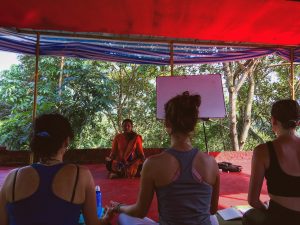
Yoga practice introduced me to the world of fitness.
It was the first consistent wellness routine I had in my life and afforded me the perspective to understand what I wanted to do with my life. However, it was the confidence I gained from my Personal Training education and certification that inspired me to do a Yoga teacher training. With my love for travel and experiences it offers, I felt a pull that lead me to India.
If completing a YTT has ever crossed your mind, and then it has again and perhaps again, I highly recommend the experience.
Yoga Teaching Training in India
So far I have completed 700 hours of training through various locations in India. My first 200 hr training was June of 2016; it was only 9 months prior that I made the decision to go at all. It was a decision that was spontaneous but had been in the works since I was a kid.
Since I was young I dreamed of traveling to India, largely inspired by one of my favorite movies The Little Princess. Yoga enchanted me from day one when my practice began at 18. So choosing to do a YTT in the motherland of Yoga wasn’t all that surprising.
At the end of this January, I completed my 500 hr training in Kerala, India. It was a two-month course in a glorious setting of tropical Indian landscape. The resort the course was hosted in was stunning; only a five-minute walk to the beach, equipped with a lovely and spacious room, three monstrously delicious meals provided throughout the day, all the while, surrounded by a lush botanical wonderland.
I know, it sounds luxurious and dreamy, and I won’t disagree. The accommodations that my school provided were superb, which was honestly quite necessary when doing a 14 hour day that included four hours of physical practice and intensive education.
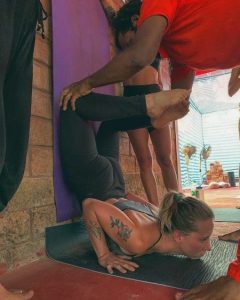
A Day in the Life of YTT
Our first class was a traditional, thus grueling, 2-hour Ashtanga practice. The class began at 5:30 am; meaning alarm was generally set for 4:15 am to give me enough time to wake up, shower and stretch my body. This was generally followed by an hour of either Pranayama or Teaching Methodology.
At 9:15 am we had Breakfast, which included a smorgasbord of fresh tropical fruits, breakfast curries, and chapattis.
Class resumed at 10:30 am; an Anatomy section followed by practices in Alignment at noon.
1-3 pm was our lunch break. Lunch was scrumptious, as all our meals were, and then I’d usually take a dip in the sea and have a fresh fruit juice or coconut at a local restaurant.
Our day ended with three more classes. One hour of Philosophy, followed by two hours of Hatha yoga, and one hour of Meditation.
Dinner was served at 7:15 pm, and I was usually dead asleep no later than 8:30 pm.
The weeks of practice were compiled by 6 long, 14 hour days, with Sundays off for Self-Study and relaxation. This was paired with at least 4 hours of physical training, which was followed by learning and applying complicated topics such as ancient yoga philosophy, modern anatomy, and teaching methods.
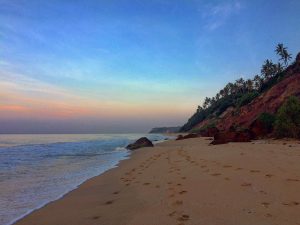
For the sake of survival, I interspersed with daily swims in the Arabian Sea, freshly squeezed juices, divine Indian food, and hanging out with some of the greatest people I’ve met. Simply put, it was fantastically hard and deliciously challenging. I was not only learning about how to be a teacher but about who I was and wanted to be… which is what I think we’re all looking for when signing up for a course like this.
I specifically chose my school for its traditional Indian teachers and teaching style, for its focus on the spirituality within yoga, and for new mental and physical challenges. I also love to travel, explore new cultures and meet new people. It’s an oddly intimate thing to spend two months with the same people, doing something like this.
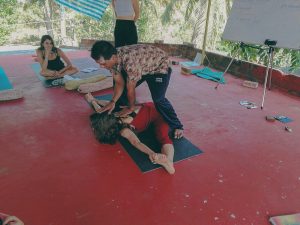
Choosing a Yoga Teacher Training
If you are wanting to do a YTT it is important to know what the course will focus on. Do your homework on the Asana practices/style you want to learn, and decide if the schedule is something you’re honestly willing to stick with for a minimum of three to four weeks.
There is also the location of the course to consider. Destination courses, especially in India and Bali, seem to have a special appeal to them. The idea of traveling somewhere new and exotic is tantalizing. However, completing a course in a foreign country adds a few extra hoops to jump through.
For places like Asia, a Visa will be necessary, along with travel vaccinations and travelers insurance. Researching what to expect of the climate and the culture is important, as to avoid unnecessary illness or uncomfortable social situations.
There is also the inevitable fact that you will at some point, or many points, get something like Delhi Belly. With such a significant change in environment, food and water quality, one is bound for a few Hail Mary runs to the restroom.
I don’t mean to come across discouraging, only to give a realistic expectation of what can occur while traveling abroad. It can be misconstrued that traveling is all glamor and white sand beaches, and that depiction isn’t too far off. Yet, there are the mundane and downright unpleasant occurrences that can be experienced during any trip. It is important to understand this, especially if also trying to complete an intensive course all the while.

Traveling for a YTT is one of the most fantastic experiences I’ve had. The inconsequential inconveniences were easily outweighed by the magic of exploring India. It is difficult to adequately describe how life-changing my travels have been, and I believe it to be unnecessary. For those who truly yearn to travel will not be put off by the few drawbacks, knowing the invaluable experiences to be gained.
There are so many different ways to train! Some are like the one I signed on for, where you go away and completely immerse yourself into the culture and the training. Others are spread out over months, working on them over the weekends through a local yoga studio. Some have a larger focus on physical and anatomical concepts. Some are more based in meditation and philosophy.
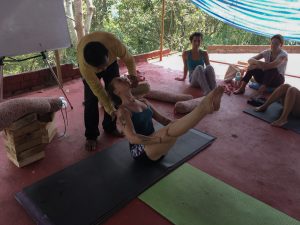
Finding the course that will best suit you is the most important thing to consider. Because they are incredible, and inspiring and could easily offer one of the best experiences you ever have, not only as a training but as a life experience. Overall, I can guarantee that your body and your mind will be challenged in ways you won’t expect, and that is a unique and truly beneficial experience for each individual.
If you have a genuine desire to do a YTT, I urge you to peruse it! It will expand your perspective, mind, and knowledge, which you can keep for a lifetime.
Alex has her A.S in Exercise Science and is a certified Personal Trainer with NFPT and NSCF. She recently traveled to India to gain her 200 hr yoga teacher certification where she studied the ancient practice at its origins. Alex has spent time teaching yoga in Spain while volunteering at a yoga retreat and is currently working at her local college instructing two fitness courses. Alex wants to share with her clients and students the mental, physical and emotionally healing qualities of exercise and movement. She believes everyone should have a healthy relationship with their bodies and strives to thread that concept throughout her career.

